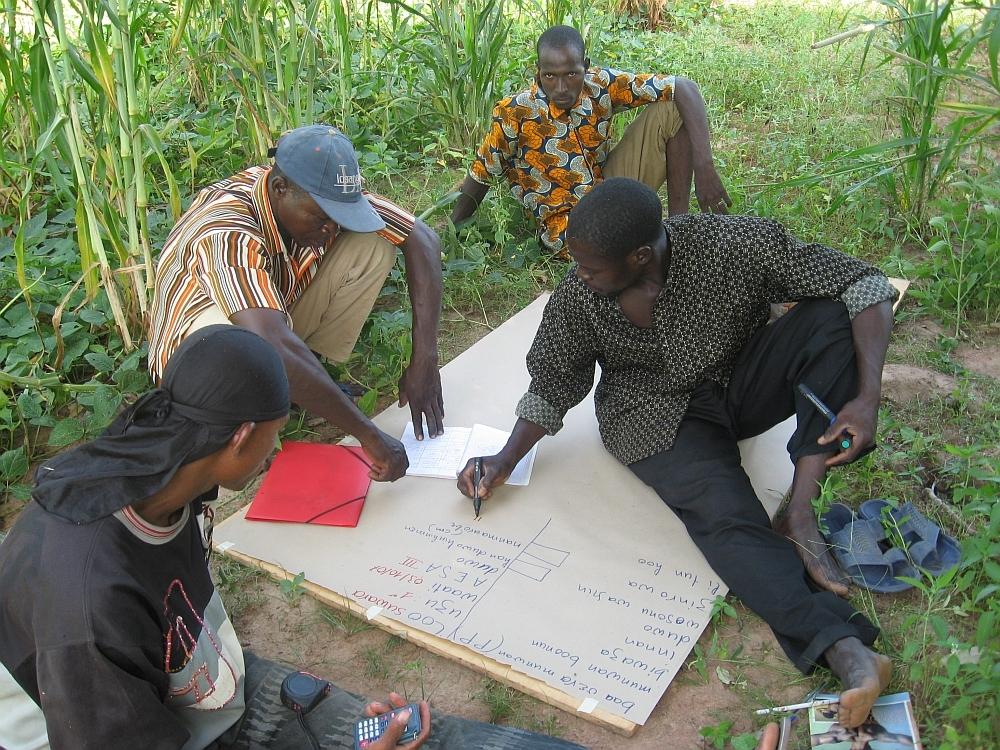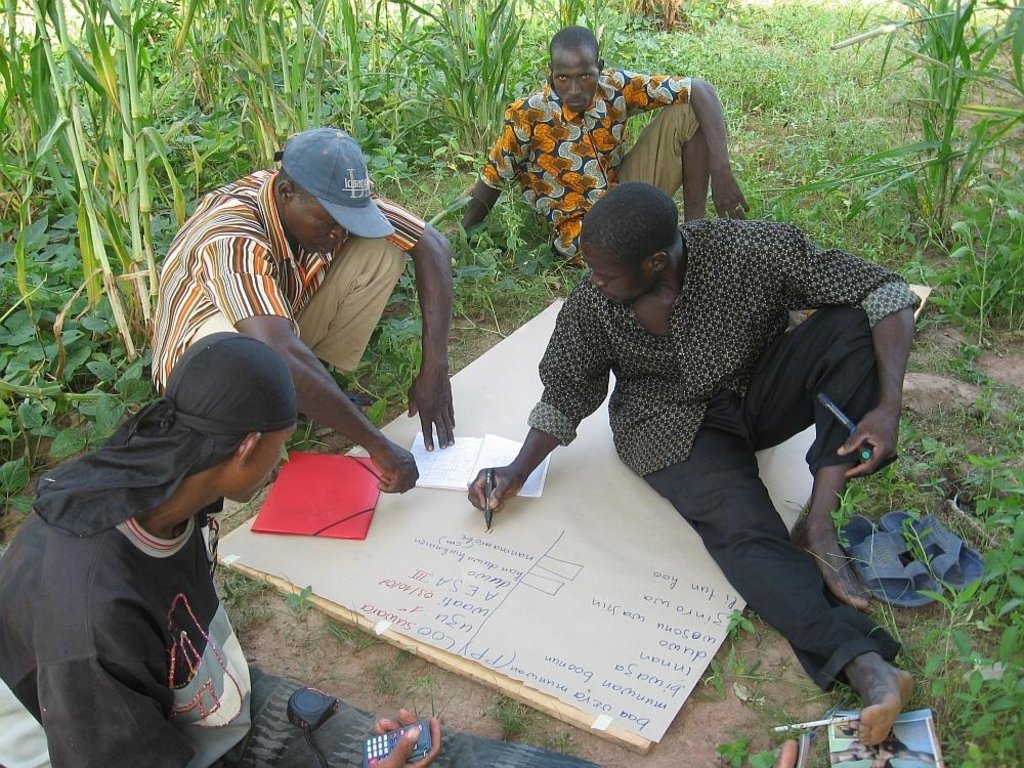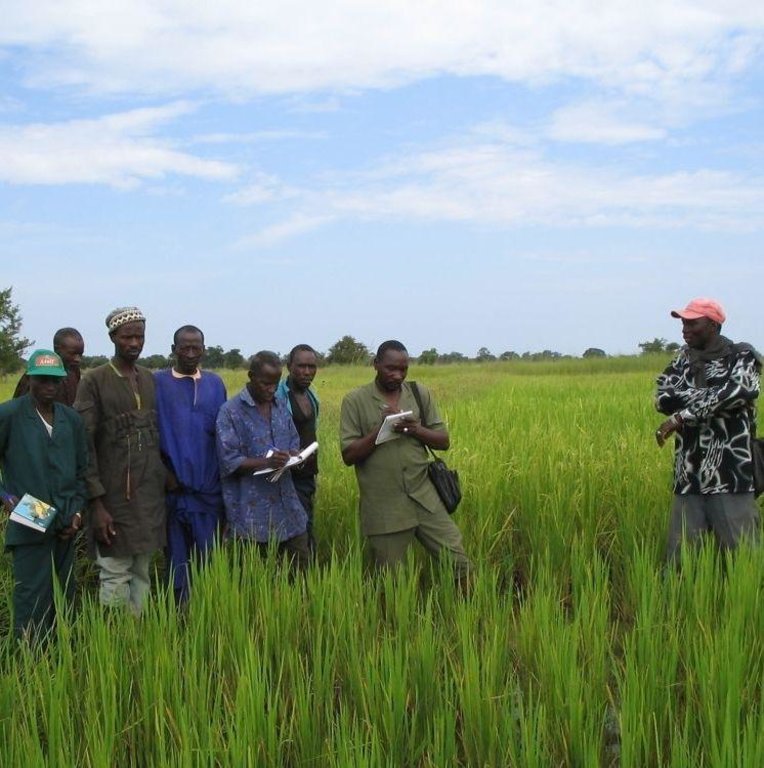Participatory Learning and Action Research for Integrated Rice Management (PLAR-IRM) [Mali]
- Creación:
- Actualización:
- Compilador: Dieter Nill
- Editor: –
- Revisor: Laura Ebneter
Apprentissage participatif/recherche-action pour la gestion intégrée du riz (French)
approaches_2502 - Mali
Visualizar secciones
Expandir todo Colapsar todos1. Información general
1.2 Detalles de contacto de las personas de referencia e instituciones involucradas en la evaluación y la documentación del Enfoque
Especialista MST:
Guindo Idrissa
idrissa.guindo@helvetas.org
HELVETAS - Swiss Intercooperation
Mali
Especialista MST:
Keita Lassana
lassana.keita@helvetas.org
HELVETAS - Swiss Intercooperation
Mali
Especialista MST:
Dacko Maïga Rosaline
rosaline.dacko@helvetas.org
HELVETAS - Swiss Intercooperation
Mali
Nombre de la(s) institución(es) que facilitaron la documentación/ evaluación del Enfoque si fuera relevante)
Deutsche Gesellschaft für Internationale Zusammenarbeit (GIZ) - AlemaniaNombre de la(s) institución(es) que facilitaron la documentación/ evaluación del Enfoque si fuera relevante)
HELVETAS (Swiss Intercooperation)1.3 Condiciones referidas al uso de datos documentados mediante WOCAT
¿Cuándo se compilaron los datos (en el campo)?
01/07/2012
El compilador y la/s persona(s) de referencia claves aceptan las condiciones acerca del uso de los datos documentados mediante WOCAT :
Sí
2. Descripción del Enfoque MST
2.1 Breve descripción del Enfoque
An approach to develop farmers’ capacities to observe and analyse their rice management and growing practices; and to identify major constraints, then test, adapt and innovate with ways to improve integrated rice management.
2.2 Descripción detallada del Enfoque MST
Descripción detallada del Enfoque MST:
This is an educational approach for farmers, based around training groups of 20 to 25 adults and drawing on the experience of the farmers participating in the group. Farmers undertake their own analyses of the problems at hand and find their own solutions.
The PLAR-IRM approach comprises the following stages: Farmers start out by exchanging their knowledge, opinions, experiences and practices with each other and then observe crop behaviours. They compare, interpret, analyse and understand the causes for the differences observed. Next they weigh up the actions to be taken, testing new ideas and then putting them into practice. Farmers organise themselves (individually and as a group or community) to undertake the activities. Following this, functional networks are created with other farmers, extension/research services and any other support service. During the process, farmers’ learning and understanding is facilitated so that they can make better and more informed decisions, with the end goal of more productive and sustainable integrated rice management. The animators/facilitators use the learning tools provided in the PLAR-IRM training modules. These tools have been developed primarily to encourage farmers to exchange their experiences and to observe, reflect, analyse, conceptualise and test as a group. Many of the tools are based on the visualisation of phenomena and bring aspects to light that beneficiaries were previously unaware of. The 11 PLAR-IRM learning tools are: agricultural calendar, lowland area map, transect, plenary exchange session, the PLAR-IRM team’s introduction of new ideas, field observation in sub-groups, observation synthesis/Feedback, the IRM plot, trials, monitoring sheet, evaluation of gains.
Stages of implementation: 1)train the PLAR-IRM field teams, 2)devise projects for rolling out the PLAR-IRM approach more widely, 3)the approach calls for the intervention of specialist technical agents or technicians trained in PLAR-IRM, known as animators/facilitators, who help farmers to find their own solutions to problems and to increase their capacity for managing rice growing endeavours, 4)training sessions with farmers are very practical and are held in farmers’ fields. The facilitator prompts farmers to share their experiences and keeps lectures to a minimum. This stimulates farmers’ capacities to observe and interpret actions and to decide on the steps to take. Training sessions take place once a week. They begin around one month before the rice season starts and continue throughout the entire rice growing season, until after the harvest. Each session lasts one to two hours. Once the problem areas have been identified, farmers can try out new ideas. The facilitators help the farmers conduct simple trials to compare one or several new practices to their current techniques. Farmers agree among themselves on their objectives and the protocols to draw up. Practical sessions based around visits to field test sites give them the opportunity to carry out observations and adapt the new practices to their existing rice growing management context. The method is described in a manual (consisting of around 30 modules).
The lowland management committee organises teams and session calendars, and identifies plots. PLAR-IRM trainers plan modules and sessions, mobilise researchers, devise training content, conduct practical observation exercises, take notes and produce syntheses, and deploy evaluation tools for participatory learning. Farmers take part in the learning modules, apply the module learning in the field, carry out observations, contribute to decision-making, act on decisions made, perform monitoring and evaluation, and share their experience and expertise with others. The project team offers support, strategic organisation and coordination, liaises with local people, introduces the trainers, and contributes to the evaluation and capitalisation processes.
2.3 Fotos del Enfoque
2.5 País/ región/ lugares donde el Enfoque fue aplicado
País:
Mali
Región/ Estado/ Provincia:
Mali
Especifique más el lugar :
Sikasso, Kayes, Ségou, Mopti
2.6 Fechas de inicio y conclusión del Enfoque
Indique año del inicio:
2003
2.8 Propósitos/ objetivos principales del Enfoque
The Approach focused mainly on SLM with other activities
The two main objectives of the technique are: 1)to develop farmers’ capacities to observe and analyse their rice management and growing practices; 2)to identify major constraints, then test, adapt and innovate with ways to improve integrated rice management.
The SLM Approach addressed the following problems: low rice production, lack of knowledge on different growing practices
2.9 Condiciones que facilitan o impiden la implementación de la/s Tecnología/s aplicadas bajo el Enfoque
conocimiento de MST, acceso a apoyo técnico
- impiden
lack of technical knowledge on different rice growing practices
Treatment through the SLM Approach: Farmers exchange their experiences. Technical agents or technicians trained in PLAR-IRM, known as animators/facilitators, help farmers to find their own solutions to problems and to increase their capacity for managing rice growing endeavours.
3. Participación y roles de las partes interesadas involucradas
3.1 Partes interesadas involucradas en el Enfoque y sus roles
- usuarios locales de tierras/ comunidades locales
- especialistas MST/consejeros agrícolas
- ONG
HELVETAS Swiss Intercooperation
- gobierno nacional (planificadores, autoridades)
3.2 Involucramiento de los usuarios locales de tierras/ comunidades locales en las distintas fases del Enfoque
| Involucramiento de los usuarios locales de tierras/ comunidades locales | Especifique quién se involucró y describa las actividades | |
|---|---|---|
| iniciación/ motivación | interactivo | |
| planificación | interactivo | |
| implementación | auto-movilización | |
| monitoreo y evaluación | auto-movilización | |
| Research | pasivo |
3.4 La toma de decisiones en la selección de Tecnología(s) MST
Especifique quién decidió la selección de las Tecnología/ Tecnologías a implementarse:
- solamente usuarios de tierras (autoiniciativa)
Explique:
Farmers undertake their own analyses of the problems and find their own solutions.
Decisions on the method of implementing the SLM Technology were made by by land users alone (self-initiative / bottom-up)
4. Apoyo técnico, fortalecimiento institucional y gestión del conocimiento
4.1 Construcción de capacidades / capacitación
¿Se proporcionó la capacitación a usuarios de tierras/ otras partes interesadas?
Sí
Especifique quién fue capacitado:
- usuarios de tierras
- personal de campo/ consejeros
Forma de capacitación:
- de agricultor a agricultor
Temas avanzados:
Training sessions with farmers are very practical and are held in farmers’ fields. The facilitator prompts farmers to share their experiences and keeps lectures to a minimum. This stimulates farmers’ capacities to observe and interpret actions and to decide on the steps to take. Training sessions take place once a week. They begin around one month before the rice season starts and continue throughout the entire rice growing season, until after the harvest. Each session lasts one to two hours. Once the problem areas have been identified (constraints), farmers can decide to try out new ideas.
4.2 Servicio de asesoría
¿Los usuarios de tierras tienen acceso a un servicio de asesoría?
Sí
Especifique si servicio proporcionado se realizó:
- en los campos de los usuarios de tierras
Describa/ comentarios:
Name of method used for advisory service: animators/facilitators; Key elements: help farmers to find their own solutions to problems and to increase their capacity for managing rice growing endeavours, facilitator prompts farmers to share their experiences and keeps lectures to a minimum , facilitators help the farmers conduct simple trials to compare one or several new practices to their current techniques; PLAR-IRM trainers plan modules and sessions, mobilise researchers, devise training content, conduct practical observation exercises, take notes and produce syntheses, and deploy evaluation tools for participatory learning.
Advisory service is very adequate to ensure the continuation of land conservation activities
4.3 Fortalecimiento institucional (desarrollo institucional)
¿Se establecieron o fortalecieron instituciones mediante el Enfoque?
- sí, mucho
Especifique el nivel o los niveles en los que se fortalecieron o establecieron las instituciones:
- local
Especifique el tipo de apoyo:
- construcción de capacidades/ entrenamiento
4.4 Monitoreo y evaluación
¿El monitoreo y la evaluación forman parte del Enfoque?
Sí
Comentarios:
bio-physical aspects were ad hoc monitored by project staff, land users through measurements
technical aspects were ad hoc monitored by project staff, land users through observations
economic / production aspects were ad hoc monitored by project staff, land users through observations
economic / production aspects were ad hoc monitored by project staff, land users through measurements
management of Approach aspects were ad hoc monitored by project staff, land users through observations
bio-physical aspects were ad hoc monitored by project staff, land users through observations; indicators
There were no changes in the Approach as a result of monitoring and evaluation
There were no changes in the Technology as a result of monitoring and evaluation
4.5 Investigación
¿La investigación formó parte del Enfoque?
Sí
Especifique los temas:
- sociología
- economía/ marketing
- ecología
- tecnología
Proporcione detalles adicionales e indique quién hizo la investigación:
Research was carried out both on station and on-farm
5. Financiamiento y apoyo material externo
5.2 Apoyo financiero/material proporcionado a los usuarios de tierras
¿Los usuarios de tierras recibieron financiamiento/ apoyo material para implementar la Tecnología/ Tecnologías? :
No
5.3 Subsidios para insumos específicos (incluyendo mano de obra)
- ninguno
Si la mano de obra de usuarios de tierras fue un insumo sustancial, ¿fue:
- voluntario?
6. Análisis de impacto y comentarios de conclusión
6.1 Impactos del Enfoque
¿El Enfoque ayudó a los usuarios de tierras a implementar y mantener Tecnologías MST?
- No
- Sí, un poco
- Sí, moderadamente
- Sí, mucho
Farmers start out by exchanging their knowledge, opinions, experiences and practices with each other and then observe crop behaviours. They compare, interpret, analyse and understand the causes for the differences observed. Next they weigh up the actions to be taken, testing new ideas and then putting them into practice.
¿El Enfoque empoderó a grupos en desventaja social y económica?
- No
- Sí, un poco
- Sí, moderadamente
- Sí, mucho
Did other land users / projects adopt the Approach?
- No
- Sí, un poco
- Sí, moderadamente
- Sí, mucho
PLAR-IRM has been rolled out in Mali, Benin, Togo, Guinea, Côte D’Ivoire, Ghana and the Gambia. In Mali, the practice has been applied in the regions of Sikasso, Kayes, Ségou and Mopti.
Did the Approach lead to improved livelihoods / human well-being?
- No
- Sí, un poco
- Sí, moderadamente
- Sí, mucho
Increases in rice yields of between 25% and 40% can be achieved in lowland areas. Farmers’ rice-growing capacities are strengthened in terms of seeds, nurseries, plant care, irrigation, weed management, plant disease, harvesting, etc.
Did the Approach help to alleviate poverty?
- No
- Sí, un poco
- Sí, moderadamente
- Sí, mucho
Increases in rice yields and farmers’ rice-growing capacities are strengthened
6.2 Motivación principal del usuario de la tierra para implementar MST
- producción incrementada
- incremento de la renta(bilidad), proporción mejorada de costo-beneficio
- well-being and livelihoods improvement
6.3 Sostenibilidad de las actividades del Enfoque
¿Pueden los usuarios de tierras sostener lo que se implementó mediante el Enfoque (sin apoyo externo)?
- sí
Si respondió que sí, describa cómo:
Farmers undertake their own analyses of the problems at hand and find their own solutions.
6.4 Fortalezas/ ventajas del Enfoque
| Fuerzas/ ventajas/ oportunidades desde la perspectiva del compilador o de otra persona de referencia clave |
|---|
| Increases in rice yields of between 25% and 40% can be achieved in lowland areas. Farmers’ rice-growing capacities are strengthened in terms of seeds, nurseries, plant care, irrigation, weed management, plant disease, harvesting, etc. |
| The approach reinforces farming organisations’ endogenous capacities. A core of farmers master each session’s content and the PLAR-IRM modules. The method used is participatory and inclusive. Sessions are practical and take place in the field schools, which is particularly appealing to the farmers. (How to sustain/ enhance this strength: Motivating the teams of farmers is absolutely essential. Learning modules based on observation must be comprehensible and practical and delivered by competent deliverers and trainers. PLAR-IRM requires decisions made to be practical and immediately applicable. Researchers who are open to and respectful of local knowledge can facilitate the process.) |
7. Referencias y vínculos
7.2 Referencias a publicaciones disponibles
Título, autor, año, ISBN:
Manual of Good Practices in Small Scale Irrigation in the Sahel. Experiences from Mali. Published by GIZ in 2014.
¿Dónde se halla disponible? ¿Costo?
http://star-www.giz.de/starweb/giz/pub/servlet.starweb
Título, autor, año, ISBN:
Defoer, T, Wopereis, M.C.S., Idinoba, P. and the PSSDRI/AKR team (2008): Curriculum d’apprentisage participatif et recherche action (APRA) pour la gestion intégrée de la culture de riz de bas-fonds (GIR) à Madagascar: Manuel du facilitateur [Participatory learning and action research (PLAR) curriculum for the integrated management of lowland rice growing (IRM) in Madagascar; Facilitator’s manual]
¿Dónde se halla disponible? ¿Costo?
Africa Rice Center, Cotonou, Benin and the Aga Khan Foundation, Geneva, Switzerland. http://www.africarice.org/publications/PLAR/madagascar/preface.pdf
Vínculos y módulos
Expandir todo Colapsar todosVínculos
No hay vínculos
Módulos
No se hallaron módulos




